NPTE retired
1/199
There's no tags or description
Looks like no tags are added yet.
Name | Mastery | Learn | Test | Matching | Spaced |
|---|
No study sessions yet.
200 Terms
4
Which of the following is the SAFEST way to measure exercise intensity with a patient taking a beta-blocker?
1. Performing oximetry
2. Taking the patient's pulse
3. Taking the patient's blood pressure
4. Asking about the patient's perceived level of exertion
2
To avoid substitution during range of motion assessment for forearm pronation and supination, the patient should be seated with the:
1. elbow fully extended, and the shoulder in neutral adduction.
2. elbow stabilized at 90° of flexion, and the shoulder in neutral adduction.
3. elbow stabilized at 90° of flexion, and the shoulder in 45° abduction.
4. wrist fully extended, and the shoulder in 45° abduction.
3
A patient has a full-thickness burn to the antecubital region. Which of the following positions is BEST for splinting the extremity?
1. Shoulder abduction and medial (internal) rotation
2. Elbow flexion and pronation
3. Elbow extension and supination
4. Shoulder adduction and lateral (external) rotation
4
Compression of the S1nerve root is MOST likely to result in weakness of which muscle?
1. Iliacus
2. Rectus femoris
3. Sartorius
4. Fibularis (peroneus) longus
3
Which of the following statements is true regarding disposal of contaminated waste in a health care facility?
1. As long as all soiled waste is placed in a bag marked for hazardous waste, no other specific guidelines are required.
2. As long as all soiled waste is double-bagged and placed outside the patient treatment area, no other specific guidelines are required.
3. Federal safety guidelines describe standard methods for disposal of contaminated waste according to amount and type of fluids involved.
4. Guidelines developed by individual facilities should indicate which color of bag is used for each type of waste for that particular facility.
1
Which of the following is an effective method to increase the amount of weight-bearing on the lower extremities when exercising in water?
1. Decrease the depth of water.
2. Increase the depth of water.
3. Increase the speed of the exercise.
4. Decrease the speed of the exercise.
1
A patient sustained a displaced fracture to the right lateral epicondyle resulting in wrist drop. A physical therapist assistant should suspect injury to which structure?
1. Radial nerve
2. Ulnar nerve
3. Median nerve
4. Brachial plexus
2
Tapping or vibration of the skin over the posterior calf is MOST likely to have which of the following effects?
1. Inhibiting plantar flexion
2. Facilitating plantar flexion
3. Inhibiting eversion
4. Facilitating eversion
4
A patient with a posterolateral lumbar disc herniation walks with the trunk in slight flexion and rotation. Which of the following positioning strategies for the patient at work would MOST reduce the chance of additional pressure on the injury?
1. Maintain the current standing posture as much as possible.
2. Sit as much as possible using a normal erect posture.
3. Sit as much as possible with the trunk posture in slight flexion.
4. Stand with a normal erect posture as much as possible.
4
During auscultation over the chest of a patient with chronic obstructive pulmonary disease, crackles were noted in bilateral upper lobes, posterior segments. In which position should the patient be placed for postural drainage?
1. Supine on a flat table with a pillow under the knees
2. Seated leaning back on a folded pillow at a 30° angle
3. Supine on a table tilted 20° with the head down, on either side
4. Seated leaning forward over a folded pillow at a 30° angle
4
A patient rocks back and forth repeatedly before being able to transition from sitting position to standing position. Which of the following muscles is MOST likely to be weak?
1. Gluteus medius
2. Erector spinae
3. Iliopsoas
4. Quadriceps
3
A patient with asthma begins to exhibit wheezing and becomes very anxious. Which of the following inflammatory reactions would MOST likely be occurring in the patient?
1. Bronchodilation and increased airway resistance
2. Bronchodilation and decreased airway resistance
3. Bronchoconstriction and increased airway resistance
4. Bronchoconstriction and decreased airway resistance
1
Slow, sustained application of which of the following manual techniques is MOSTlikely to decrease muscle spasm and reduce pain?
1. Joint traction
2. Joint approximation
3. Muscle resistance
4. Light touch
2
To correctly fit a single-point cane, the handpiece should be level with which of the following structures?
1. Iliac crest
2. Greater trochanter
3. Femoral head
4. Anterior superior iliac spine
1
A physical therapist assistant moves a patient's left upper extremity into different positions and asks the patient to demonstrate the same position with the right upper extremity with the eyes closed. The assistant is assessing the patient's:
1. proprioception.
2. graphesthesia.
3. cortical reflexes.
4. coordination.
3
A patient with a T6 spinal cord level (ASIA Impairment Scale A) will have the MOST difficulty performing which of the following functions?
1. Transitioning from supine to sidelying position
2. Transitioning from supine to long sitting position
3. Coughing and expelling secretions
4. Breathing without artificial ventilation
1
Which of the following strategies is BEST for making informed clinical decisions about a patient's treatment interventions?
1. Systematically review current research relevant to the patient's problem.
2. Alternate interventions to determine which is most effective for the patient.
3. Ask another health care provider to be a mentor during the patient's treatment.
4. Use treatment interventions based on current skill and knowledge.
1
What type of wound is MOST commonly associated with tunneling?
1. Neuropathic
2. Traumatic
3. Venous insufficiency
4. Arterial insufficiency
2
A child with myelomeningocele is experiencing rhinitis, urticaria, respiratory distress, and swelling around the mouth and eyes. These symptoms are MOST consistent with which of the following conditions?
1. Impetigo
2. Latex allergy
3. Tinea corporis
4. Atopic dermatitis
4
A physical therapist assistant is observing the patient performing the exercise in the photograph. The patient reports increased pain radiating into the right lower extremity. What action should the assistant take FIRST?1. Have the patient stop exercising and contact the physical therapist.
2. Have the patient change to a supine knees-to-chest exercise.
3. Instruct the patient to perform pelvic tilt exercises and partial sit-ups.
4. Instruct the patient to return to lying prone and monitor the patient's symptoms.
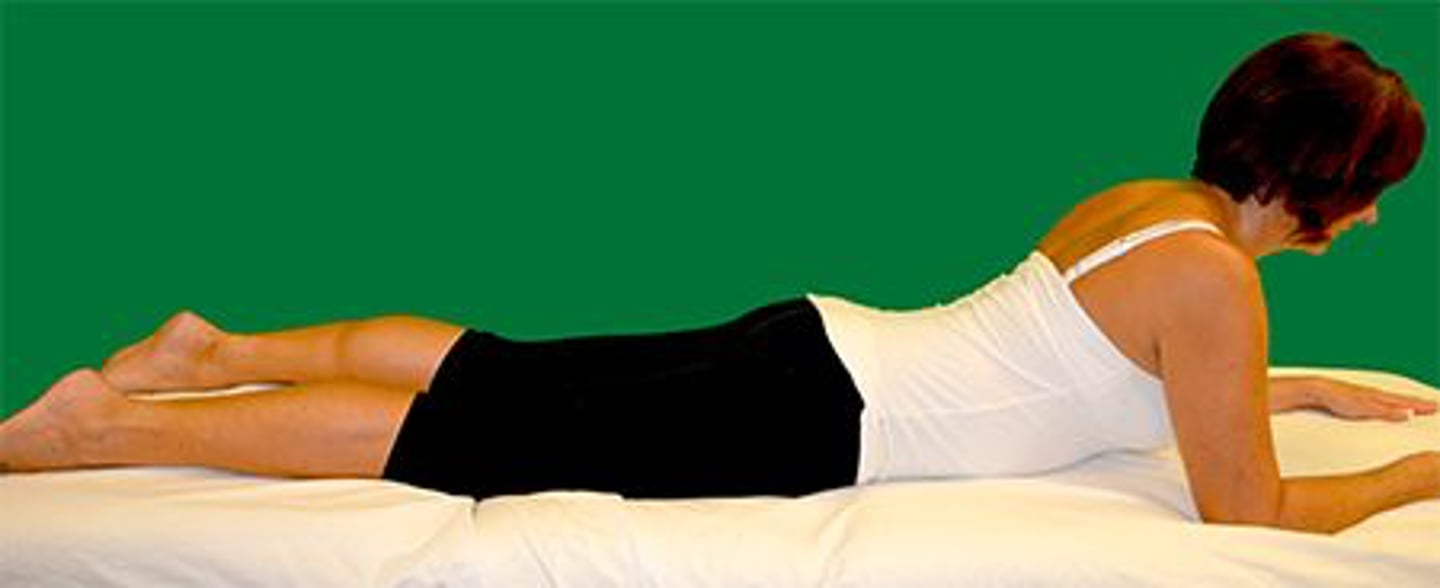
4
A dual-energy x-ray absorptiometry (DXA) test is MOST often used to confirm which of the following conditions?
1. Bone neoplasm
2. Fracture
3. Scoliosis
4. Osteoporosis
1
Which of the following signs or symptoms MOST likely indicates dehydration?
1. Confusion
2. Increased sweating
3. Tingling in the lower extremities
4. Aching calves
4
Which of the following measurements would provide the BEST data about joint effusion following total knee arthroplasty?
1. Determination of the amount of weight tolerated in standing position
2. Determination of the strength of the quadriceps muscle
3. Length of the incision measured on the anterior aspect of the knee
4. Girth measured at the level of the medial joint line
1
During cardiac rehabilitation exercises, which of the following events indicates a need to stop the patient's exercise?
1. Blood pressure increases from 160/95 mm Hg to 195/115 mm Hg.
2. The patient's rating of perceived exertion on the Borg scale is "somewhat hard" (13/20).
3. The patient is breathing at a rate of 16-18 breaths/minute.
4. Pulse rate increases from 85 bpm to 110 bpm.
3
The periwound pigmentation shown in the photograph is MOST likely to be associated with which of the following wound types?
1. Diabetic
2. Neuropathic
3. Venous insufficiency
4. Arterial insufficiency

2
A patient who has Parkinson disease should AVOID which of the following therapeutic exercises?
1. Seated rows with moderate resistance
2. Sit-ups in supine position
3. Standing hip abduction
4. Step-ups
4
A patient with hyperthyroidism is performing a strengthening program. Which of the following patient features would be MOST important for a physical therapist assistant to monitor?
1. Intolerance to cold
2. Glucose levels
3. Sensation
4. Muscle weakness
1
The orthosis shown in the photograph is TYPICALLY used for a patient who has which of the following conditions?
1. Carpal tunnel syndrome
2. Osteoarthritis of the thumb (1st digit)
3. Dupuytren contracture
4. Postoperative flexor tendon repair
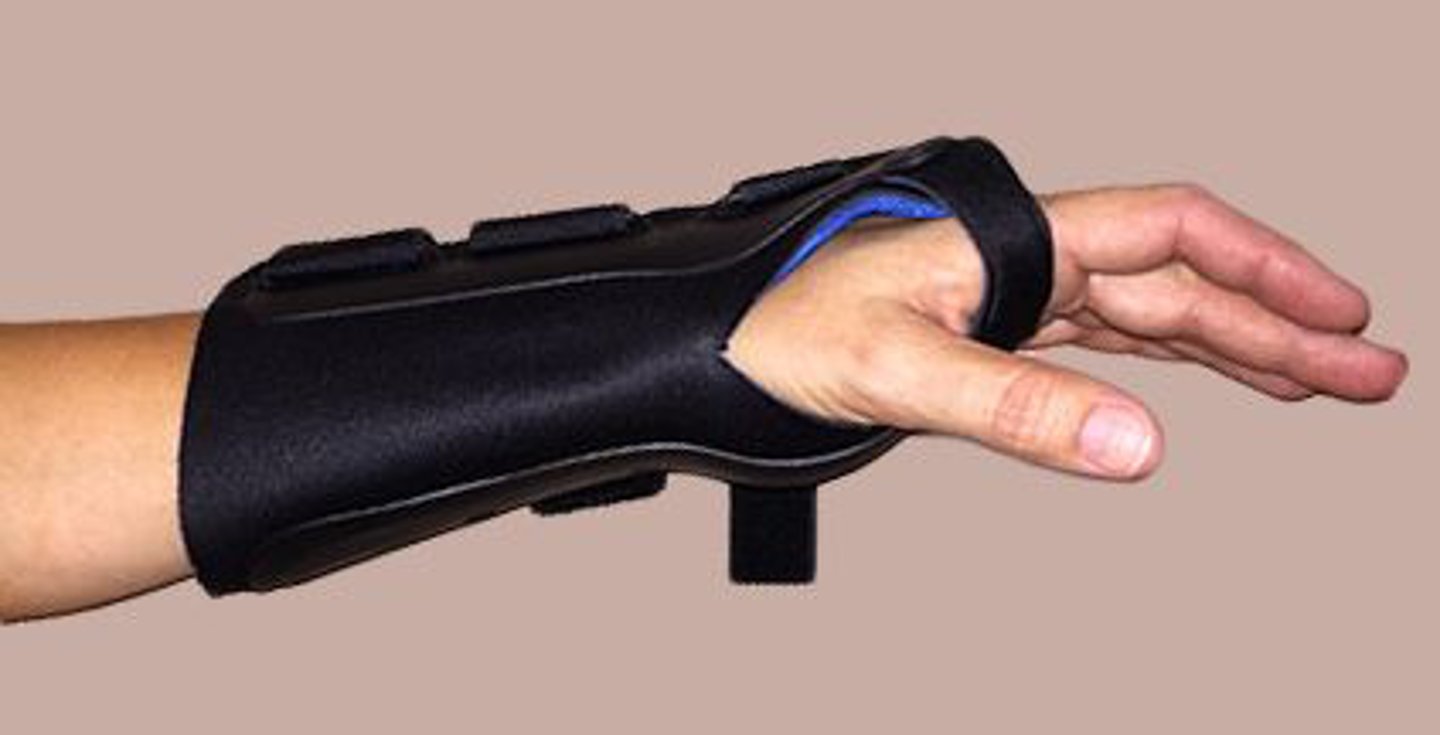
1
Which of the following conditions is a benign tumor of vascular/lymphatic tissue?
1. Hemangioma
2. Osteoma
3. Kaposi sarcoma
4. Liposarcoma
4
Which of the following conditions is related to the presence of multiple myeloma?
1. Edema
2. Jaundice
3. Headaches
4. Osteoporosis
1
A physical therapist assistant is instructed to administer ultrasound for joint capsular tightness in a patient's hip. Which of the following settings is MOST appropriate?
1. Continuous ultrasound at a frequency of 1 MHz
2. Continuous ultrasound at a frequency of 3 MHz
3. Pulsed ultrasound at a frequency of 1 MHz
4. Pulsed ultrasound at a frequency of 3 MHz
3
What postural abnormality is typically seen in a child in the early stages of Duchenne muscular dystrophy?
1. Scoliosis
2. Torticollis
3. Increased lumbar lordosis
4. Increased thoracic kyphosis
3
The results of the test shown in the photograph reveal asymmetrical hyporeflexia. The patient is MOST likely to have difficulty with which of the following tasks?
1. Reaching across the body to grab a seat belt
2. Opening a jar
3. Pushing off the armrest of a chair during a sit-to-stand transfer
4. Carrying a laundry basket at waist height
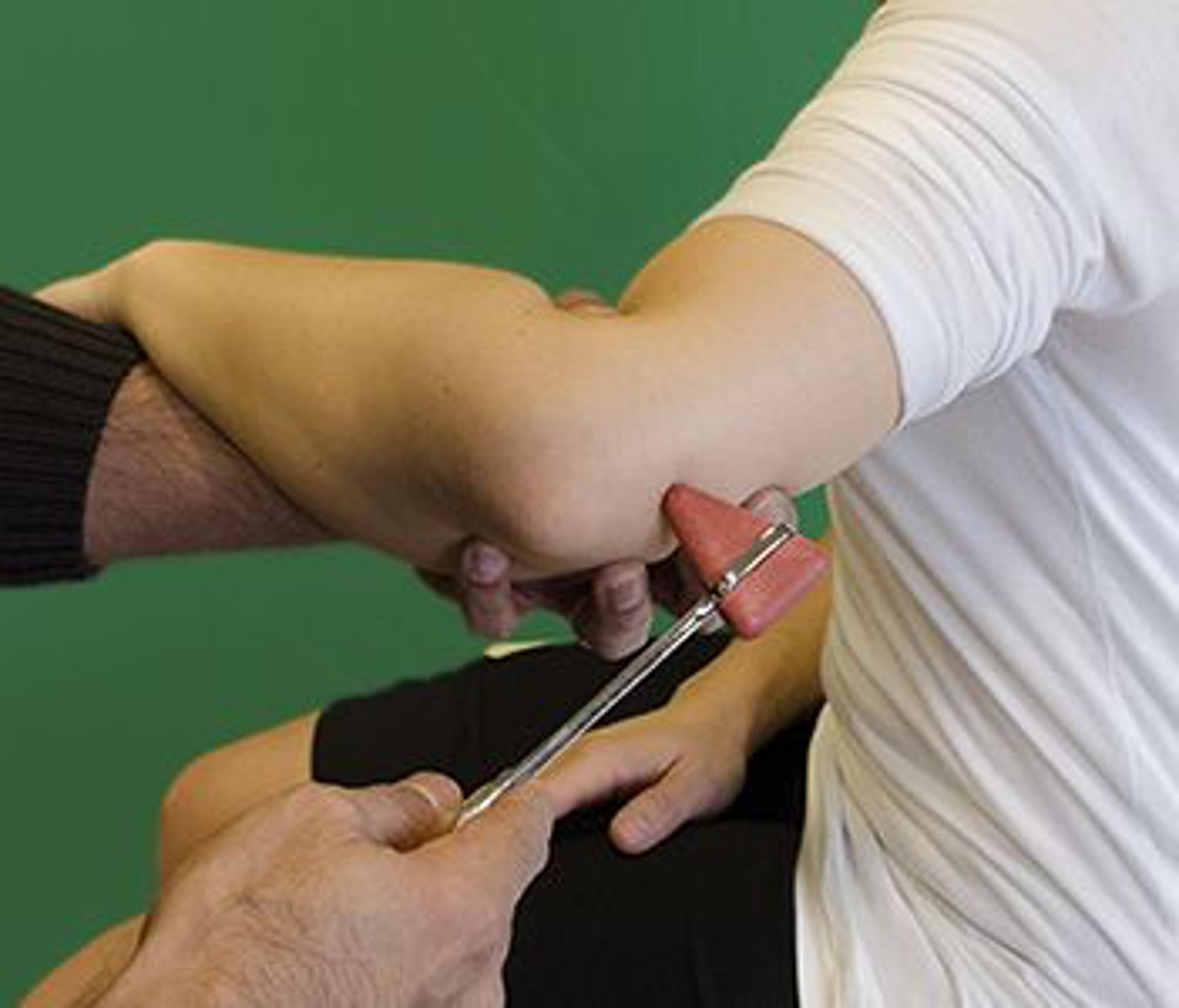
2
Which of the following adjustments to a standard wheelchair would be MOSTappropriate for a person who has hemiplegia?
1. Raised seat height
2. Lowered seat height
3. Increased seat depth
4. Decreased seat depth
3
The presence of Heberden and Bouchard nodes is MOST likely a sign of what disease process?
1. Gout
2. Fibromyalgia
3. Osteoarthritis
4. Rheumatoid arthritis
1
A patient who is being treated for osteomyelitis reports a new rash on the chest and abdomen. Which of the following medications is MOSTlikely responsible for the adverse reaction?
1. Antibiotic
2. Beta-blocker
3. Angiotensin-converting enzyme (ACE) inhibitor
4
A plan of care for a patient includes the use of iontophoresis at 40 milliampere-minutes to reduce inflammation. Which of the following treatment parameters would be indicated?
1. 1 milliampere for 40 minutes using lidocaine with negative polarity
2. 2 milliamperes for 20 minutes using lidocaine with positive polarity
3. 1 milliampere for 40 minutes using dexamethasone with positive polarity
4. 2 milliamperes for 20 minutes using dexamethasone with negative polarity
2
During a strengthening exercise routine, a patient reports the progressive onset of a headache. Which of the following measurements should be taken FIRSTwhen exercise is stopped?
1. Heart rate
2. Blood pressure
3. Respiratory rate
4. Saturated blood oxygen level
3
Which method of exercise is MOSTappropriate for the lower extremities of a patient who has an L1 spinal cord injury (ASIA Impairment Scale A)?
1. Active exercise
2. Active assistive exercise
3. Passive exercise
4. Progressive resistive exercise
2
After 8 weeks of bed rest, a patient begins gait training. While walking in the parallel bars, the patient reports fatigue and dizziness. The patient's heart rate is 125 bpm. Which of the following vital signs is MOST important for the physical therapist assistant to check?
1. Temperature
2. Blood pressure
3. Oxygen saturation
4. Respiratory rate
1
What is the MOSTappropriate patient position for postural drainage and percussion of the posterior segment of the left lower lobe?
1. Prone, with a pillow under the abdomen
2. Supine, with the head elevated 45°
3. Sidelying on the right
4. Hooklying, with the head elevated 45°
3
Which of the following skin conditions is characterized by small, pus-filled pimples surrounded by erythema?
1. Tinea pedis
2. Ringworm
3. Impetigo
4. Scabies
4
A patient who has winging of the right scapula has a grade of Poor (2/5) for the affected muscle. Which of the following positions is MOST appropriate for initiating exercises to strengthen the affected muscle?
1. Standing with the right shoulder abducted and the elbow flexed
2. Prone with the right arm in 90° of abduction
3. Supine with the right shoulder and elbow flexed
4. Sidelying on the left with the right upper arm supported in 90° of shoulder flexion
2
A patient who lives alone in a small apartment has bilateral lower extremity weakness and is unable to stand to transfer but can transfer independently with a sliding board. Which of the following wheelchair components would be MOST appropriate for the patient?
1. Fixed, adjustable-height armrests and detachable leg rests
2. Removable armrests and detachable swing-away leg rests
3. Fixed armrests and removable leg rests
4. Desk-style removable armrests and fixed elevating leg rests
4
When positioning a patient for mechanical lumbar traction, which of the following positions would increase the separation of all the facet joints between two adjacent vertebrae prior to the application of the traction?
1. Left sidelying, hips extended
2. Prone, hips extended
3. Right sidelying, hips flexed
4. Supine, hips flexed
4
A patient who has gluteus medius tendinitis is MOST likely to have tenderness at which of the following locations?
1. Anterior hip capsule
2. Distal to the ischial tuberosity
3. Posterior aspect of the iliac crest
4. Proximal to the greater trochanter
3
In an initial evaluation, a physical therapist records that the anterior capsule of a patient's shoulder is tight. A physical therapist assistant should expect which of the following shoulder motions to be limited?
1. Medial (internal) rotation
2. Flexion
3. Lateral (external) rotation
4. Abduction
2
A patient who has been restricted to prolonged bed rest exhibits orthostatic hypotension upon standing. The hypotension is MOSTlikely a result of which of the following factors?
1. Increased venous tone in the lower extremities
2. Inadequate ventricular filling during diastole
3. Decreased hydrostatic pressure in the capillary beds
4. Parasympathetic stimulation of the heart
1
A physical therapist assistant is performing gait training with a patient who has Brown-Séquard syndrome. The assistant notes that the patient's standing balance worsens when the eyes are closed. Which of the following phenomena is MOSTlikely responsible for this limitation?
1. Proprioception deficit due to unilateral damage of the dorsal column
2. Proprioception deficit due to bilateral damage of the lateral columns
3. Balance deficit due to diffuse cerebellar damage
4. Balance deficit due to loss of pressure sensation in bilateral lower extremities
4
Which of the following strengthening exercises would be MOSTappropriate for a patient who has muscle weakness due to a disc herniation at L4–L5?
1. Prone knee flexion
2. Prone ankle plantar flexion
3. Seated knee extension
4. Seated ankle dorsiflexion
4
A physical therapist assistant is treating a patient with a rotator cuff repair. The plan of care has consisted of passive range of motion. The physician has ordered progression to active range of motion with gentle strengthening. The assistant should:
1. treat as ordered by the physician and document that physical therapy evaluation will follow.
2. discontinue treatment until re-evaluation can be done by the physical therapist.
3. progress to low-level active range of motion exercises and request re-evaluation by the physical therapist.
4. proceed with passive range of motion and request re-evaluation by the physical therapist.
3
A patient with an exacerbation of rheumatoid arthritis reports tightness and swelling in multiple joints. Which of the following exercises would be CONTRAINDICATED at this time?
1. Active assistive range of motion
2. Active range of motion
3. Stretching
4. Isometric
2
Which of the following postures is MOSTstable?
1. Kneeling
2. Prone on elbows
3. Quadruped
4. Sitting
4
A patient sustained a fibular head and neck fracture affecting the adjacent nerve. Which gait deviation would the physical therapist assistant expect?
1. Knee hyperextension in midstance
2. Excessive knee flexion at heel off (terminal stance)
3. Heel lift in midstance
4. Foot drop at heel strike (initial contact)
3
A seated patient is performing weight-shifting activities. Which of the following terms is the BEST description of this activity?
1. Mobility
2. Static postural control
3. Dynamic postural control
4. Skill
1
Which of the following is the MOST appropriate rationale for the use of the mechanical device pictured in the graphic?
1. To prevent the occurrence of alveolar collapse and atelectasis in postoperative patients
2. To strengthen weak expiratory muscles among patients with neuromuscular disorders
3. To decrease fatigue of inspiratory and expiratory muscles of patients who are bedridden
4. To facilitate the use of accessory muscles of respiration of patients who have respiratory distress
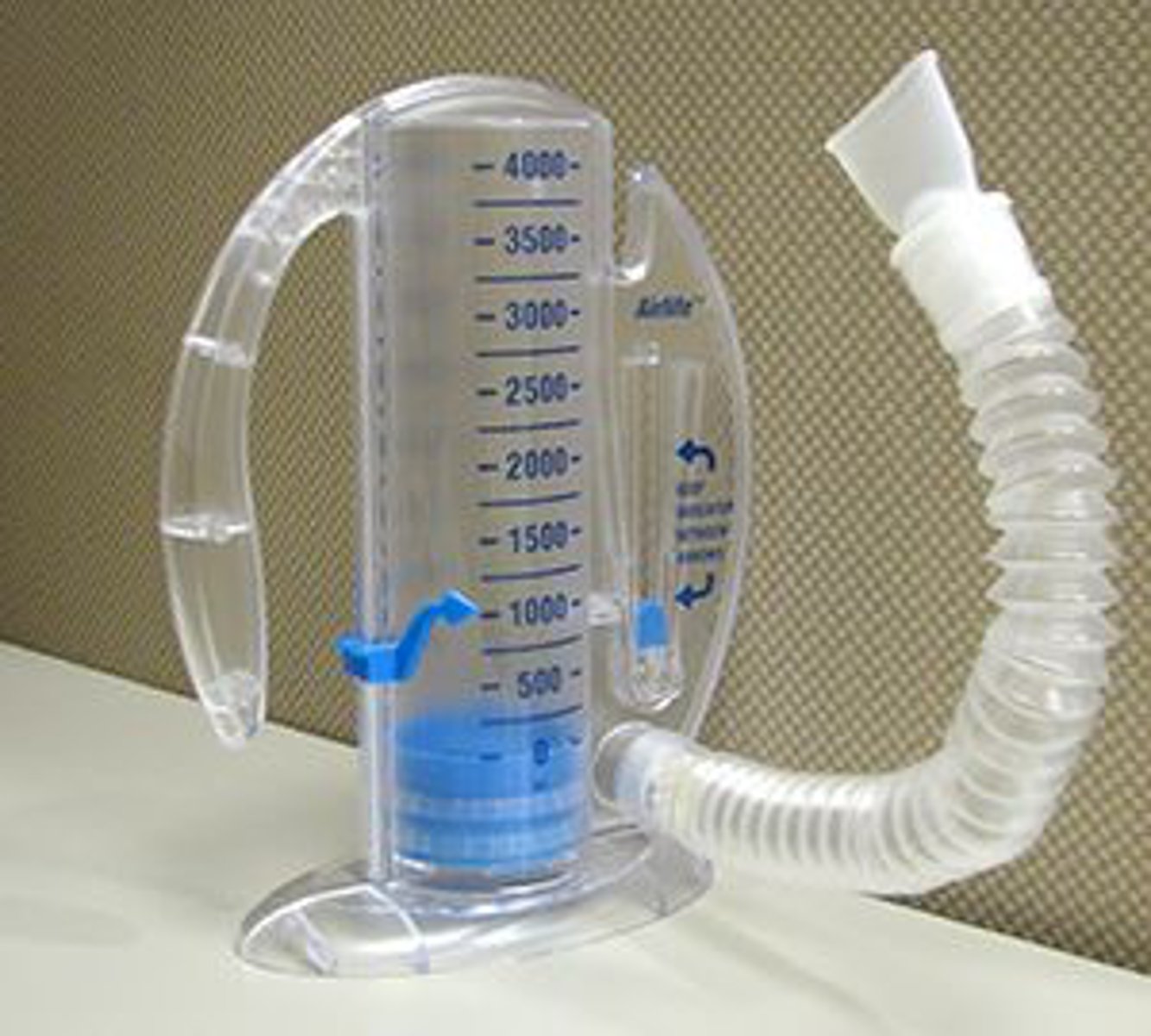
4
A patient has plantar flexor spasticity and dorsiflexion weakness in the left lower extremity following a cerebrovascular accident. The patient is receiving a biofeedback session with 2 channels monitoring the gastrocnemius and anterior tibialis muscles. The patient's goals for the biofeedback session should be to:
1. decrease the signal from the anterior tibialis and increase the signal from the gastrocnemius.
2. increase the signal from the anterior tibialis and increase the signal from the gastrocnemius.
3. decrease the signal from the anterior tibialis and decrease the signal from the gastrocnemius.
4. increase the signal from the anterior tibialis and decrease the signal from the gastrocnemius.
3
A physical therapist assistant is teaching a patient to descend a flight of stairs. The assistant should stand:
1. in front of the patient on the uninvolved side.
2. behind the patient on the uninvolved side.
3. in front of the patient on the involved side.
4. behind the patient on the involved side.
2
Which of the following instructions would be MOSTappropriate to give to the person in the photograph?
1. Straighten the knees.
2. Bend the elbows.
3. Put on a back brace.
4. Place the feet together.
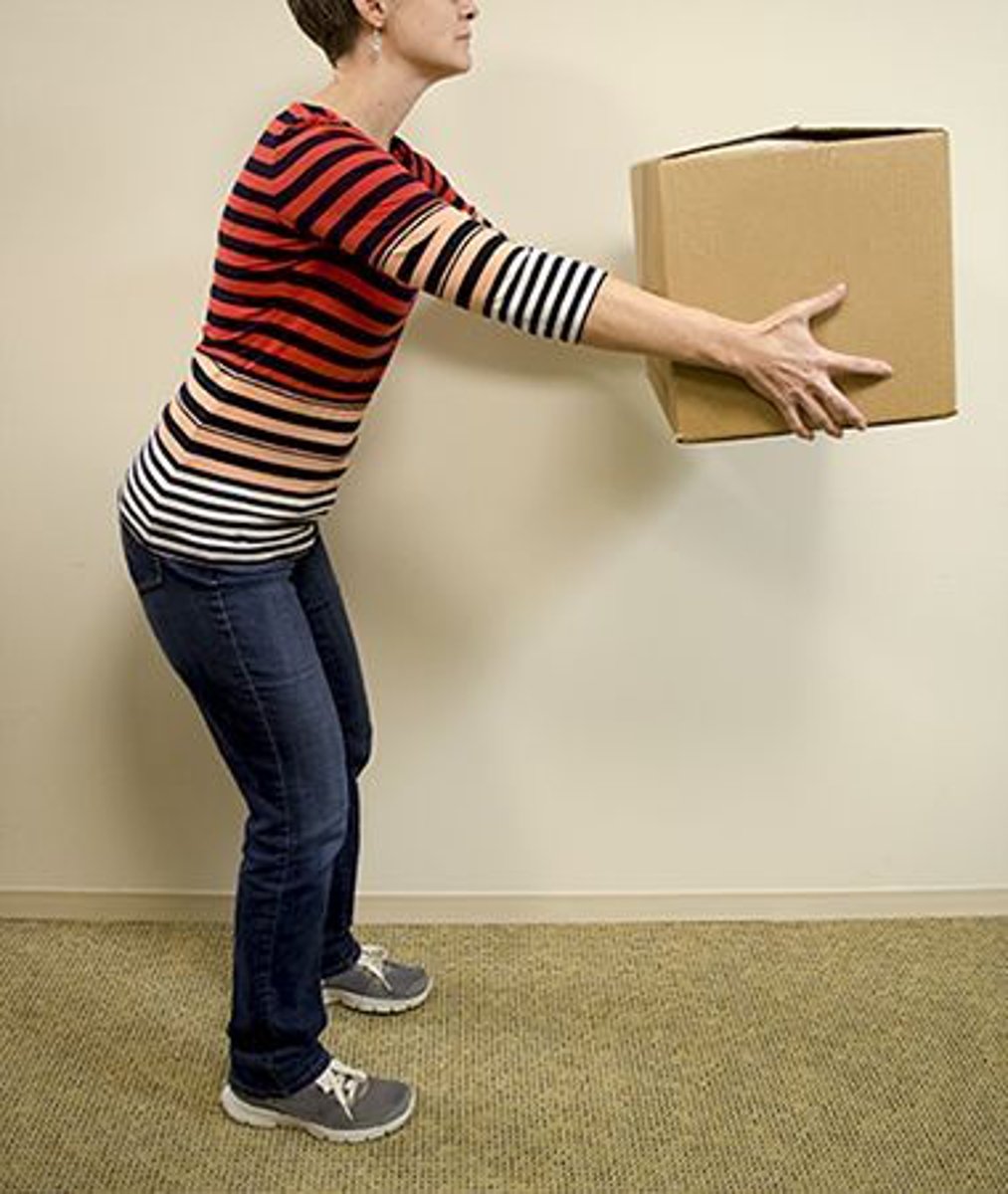
4
Which of the following findings is the BESTindication for use of a sling after a cerebrovascular accident?
1. Hypersensitivity in the involved upper extremity
2. Flexor tone in the involved upper extremity
3. Decreased strength of involved shoulder muscles
4. Shoulder subluxation greater than 1 in (2.5 cm)
1
Which of the following characteristics is LEASTlikely to be associated with the gait pattern of a patient with Parkinson disease?
1. Increased arm swing
2. Forward head
3. Forward festination
4. Decreased equilibrium
2
A physical therapist assistant instructs a patient to cough using a pillow as shown in the photograph. Which of the following aspects of the patient's medical history would warrant use of the pillow as shown?
1. The patient has a diagnosis of emphysema.
2. The patient recently underwent a cesarean section.
3. The patient has a diagnosis of abdominal aortic aneurysm.
4. The patient recently underwent a lateral thoracotomy for lobectomy.
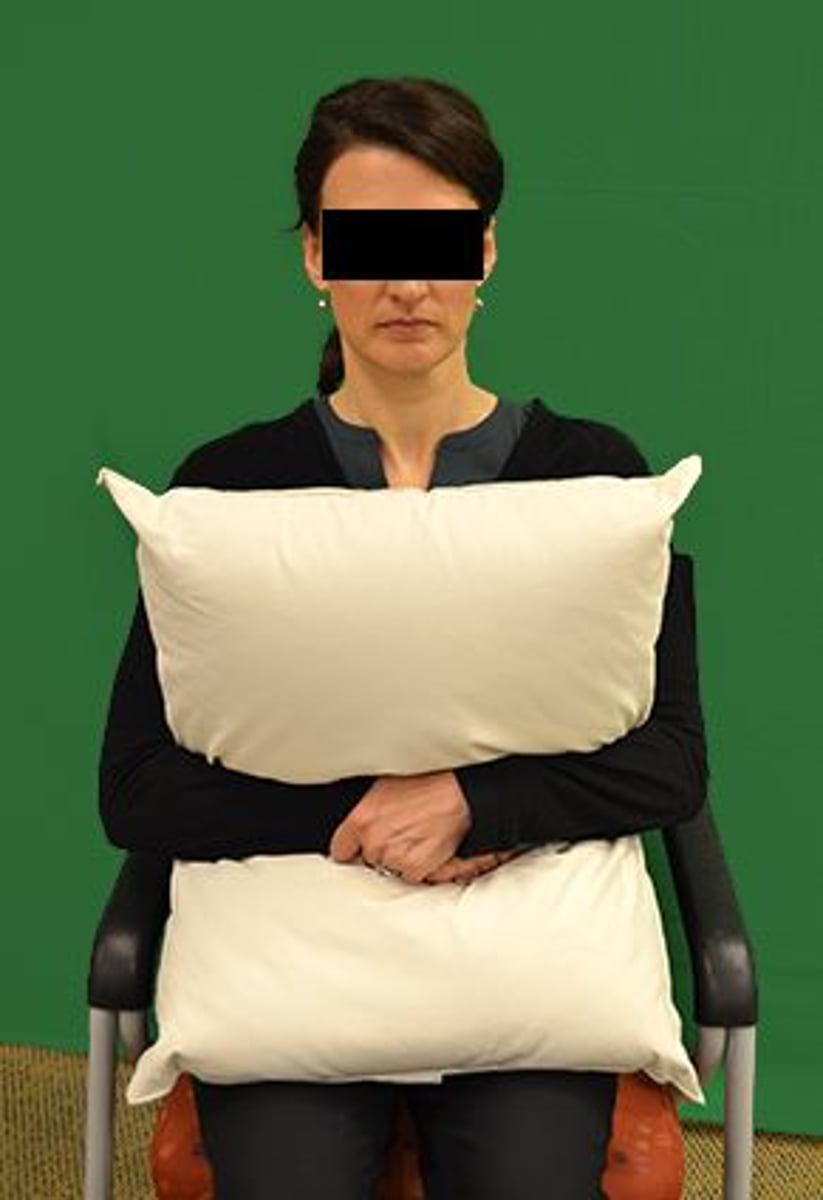
3
Which of the following is the MOST appropriate duration for application of ice massage to treat a patient's lateral ankle?
1. 10-15 minutes
2. 16-20 minutes
3. Until the patient reports a numb sensation
4. Until the patient reports a burning sensation
2
A patient sustained a burn on the dorsal surface of the hand. Intact blisters and mild weeping are noted. Which of the following descriptions BESTclassifies this burn?
1. Superficial
2. Superficial partial-thickness
3. Deep partial-thickness
4. Full-thickness
1
Which of the following findings regarding waist measurement and blood pressure would be expected in a patient with metabolic syndrome?
1. Increased waist size and elevated blood pressure
2. Increased waist size and decreased blood pressure
3. Decreased waist size and elevated blood pressure
4. Decreased waist size and decreased blood pressure
4
A patient with a history of smoking, type 2 diabetes, and peripheral vascular disease reports pain in the posterior aspect of the lower leg while performing a graded exercise test at 2.0 miles/hour (3.2 km/hour) with an elevation of 3.5%. These symptoms are MOSTconsistent with which of the following diagnoses?
1. Raynaud disease
2. Postphlebitic syndrome
3. Spinal stenosis
4. Arteriosclerosis obliterans
2
Which of the following sequences represents the normal progression of motor development in infancy?
1. Head righting, grasping and transferring objects, pivot prone
2. Head righting, pivot prone, grasping and transferring objects
3. Grasping and transferring objects, head righting, pivot prone
4. Pivot prone, head righting, grasping and transferring objects
2
Which of the following test results would MOSTlikely be seen in a patient with chronic obstructive pulmonary disease?
1. Increased expiratory flow rate
2. Increased total lung capacity
3. Decreased functional residual capacity
4. Decreased residual volume
3
When performing percussion for clearance of the apical segment of the upper lobes, what is the appropriate location for placement of the hands?
1. Anterior ribs
2. Inferior scapula
3. Above the clavicle
4. Upper back
1
Coffee-ground emesis is MOST typically indicative of which of the following conditions?
1. Erosive gastritis
2. Gastroesophageal reflux disease
3. Sliding hiatal hernia
4. Pernicious anemia
2
Which of the following factors MOST contributes to the patient's use of the position shown in the photograph forsit-to-stand activities?
1. Pseudohypertrophy
2. Proximal weakness
3. Lordosis
4. Scoliosis
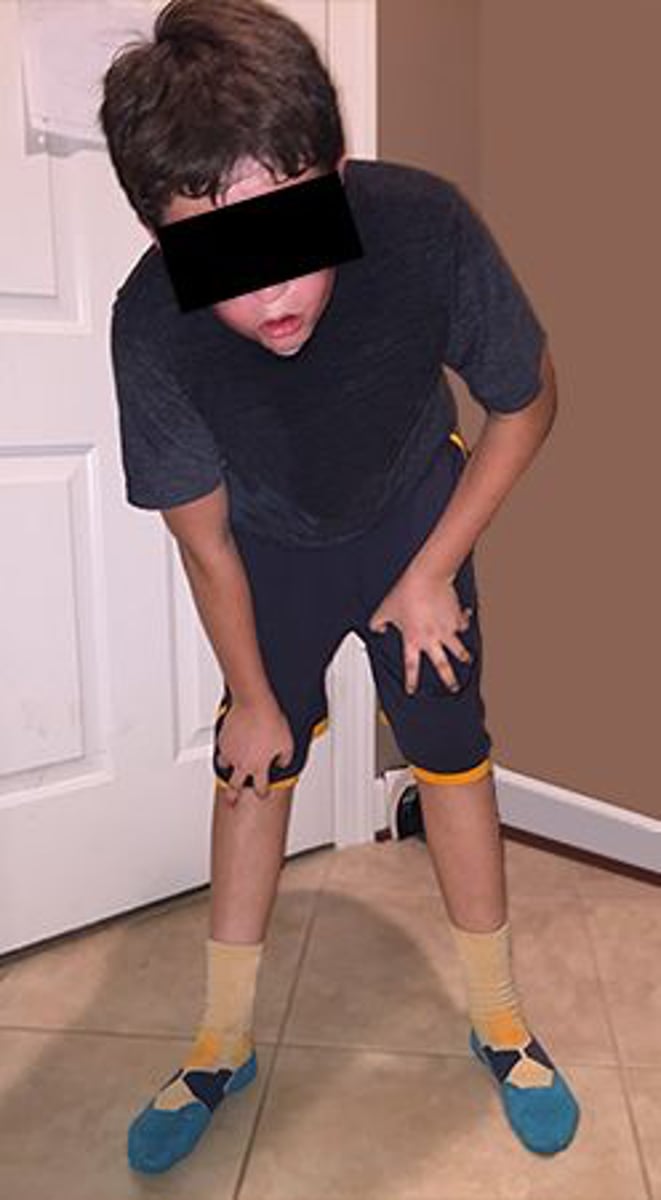
2
A patient has an initial examination score of 3 on the Modified Ashworth Scale for Grading Spasticity. Which of the following descriptions MOSTclosely represents the patient's level of spasticity?
1. No increase in muscle tone with no resistance to passive movement
2. Considerable increase in muscle tone resulting in significant resistance to passive movement
3. Slight increase in muscle tone with minimal resistance to passive movement
4. Increased muscle tone with limb moving easily through passive movement
1
Fluid depletion and electrolyte imbalance are adverse effects of which of the following classes of antihypertensive drugs?
1. Diuretics
2. Sympatholytics
3. Vasodilators
4. Calcium channel blockers
1
Which of the following nerves innervates the muscle reflex being tested in the photograph?
1. Musculocutaneous
2. Radial
3. Axillary
4. Median
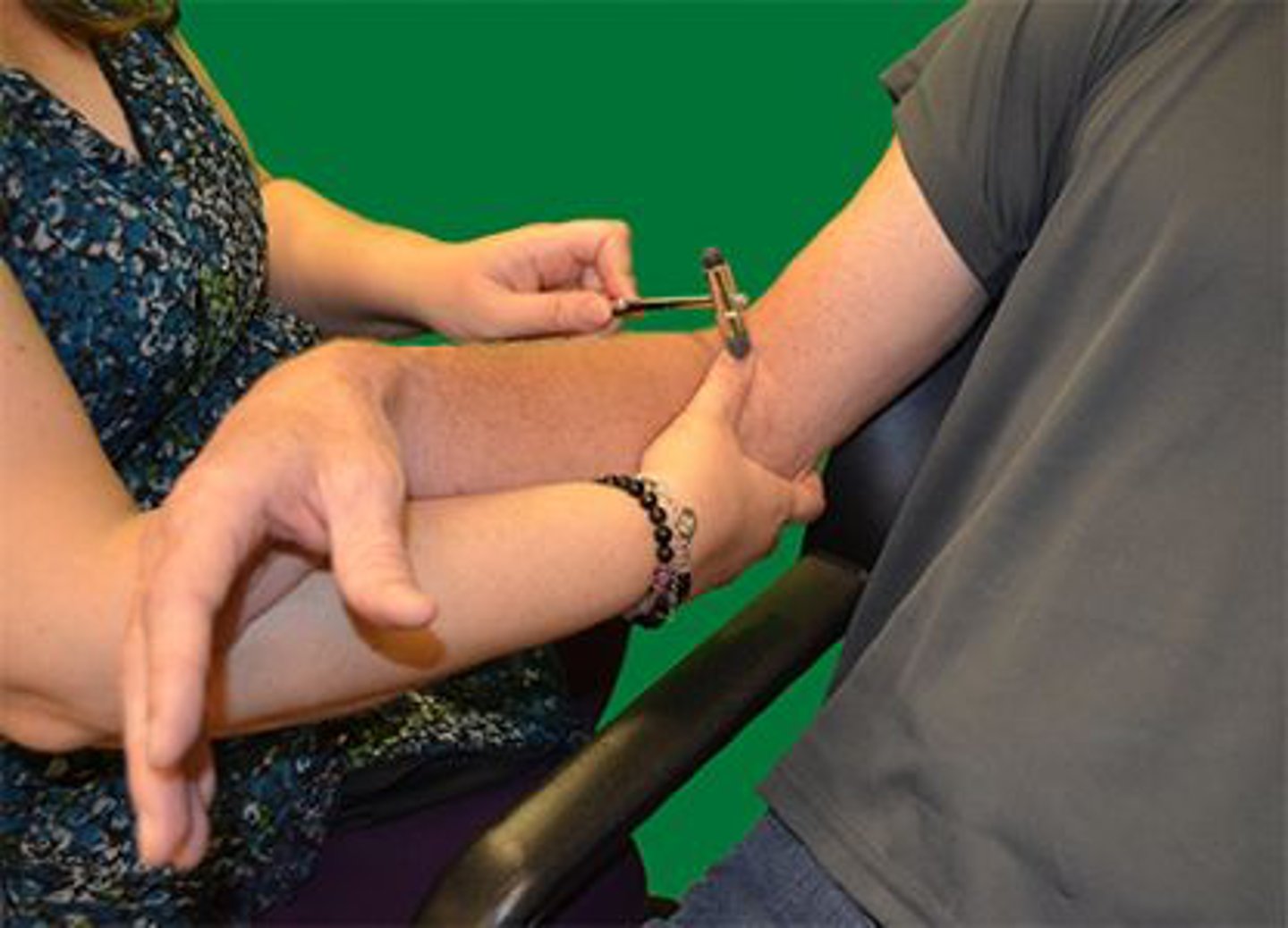
3
A patient with an acquired brain injury is at the confused-inappropriate level of the Rancho Los Amigos Levels of Cognitive Functioning Scale. Which of the following accommodations is MOST appropriate to provide for the patient during physical therapy intervention?
1. Detailed verbal explanation
2. Massed practice
3. A quiet environment without distractions
4. Variable practice
2
A patient who currently has fair balance is restricted to non-weight-bearing status on the right wrist and the left lower extremity due to fractures. Which of the following assistive devices would be MOSTappropriate for the patient?
1. Axillary crutches with platform attachment on the right side
2. Walker with platform attachment on the right side
3. Hemiplegic walker in the left hand
4. Power wheelchair with controls on the right side
4
A patient performs the movement with the starting and ending positions shown in photographs A and B, respectively. Which of the following options BEST explains the end result demonstrated in photograph B?
1. Scapular elevation and downward rotation motions are limited.
2. Pectoralis major muscles are actively insufficient.
3. Glenohumeral joint extension range of motion is restricted.
4. Latissimus dorsi muscles are passively insufficient.

3
A patient who has type 2 diabetes is being treated for a wound on the lower extremity that recently became infected. Which of the following treatments is MOSTappropriate INITIALLY?
1. Pulsed ultrasound at 3.3 MHz and 1.0 W/cm2
2. Iontophoresis using anodal stimulation with dexamethasone
3. High-voltage monophasic stimulation using cathodal stimulation
4. Moist hot pack with transcutaneous electrical nerve stimulation
1
A 65-year-old patient is referred to physical therapy for strengthening and conditioning, with activity limited to 60% of maximum heart rate. Based on this information, what is the MAXIMUM heart rate allowable for the patient?
1. 93 bpm
2. 132 bpm
3. 155 bpm
4. 171 bpm
1
A patient's rating of perceived exertion on the Borg scale is 11/20. Which of the following terms best describes the subjective exercise intensity?
1. Light
2. Hard
3. Extremely light
4. Extremely hard
2
Which of the following terms BEST describes the foot deformity shown in the photograph?
1. Pes cavus
2. Pes planus
3. Equinus foot
4. Calcaneus foot
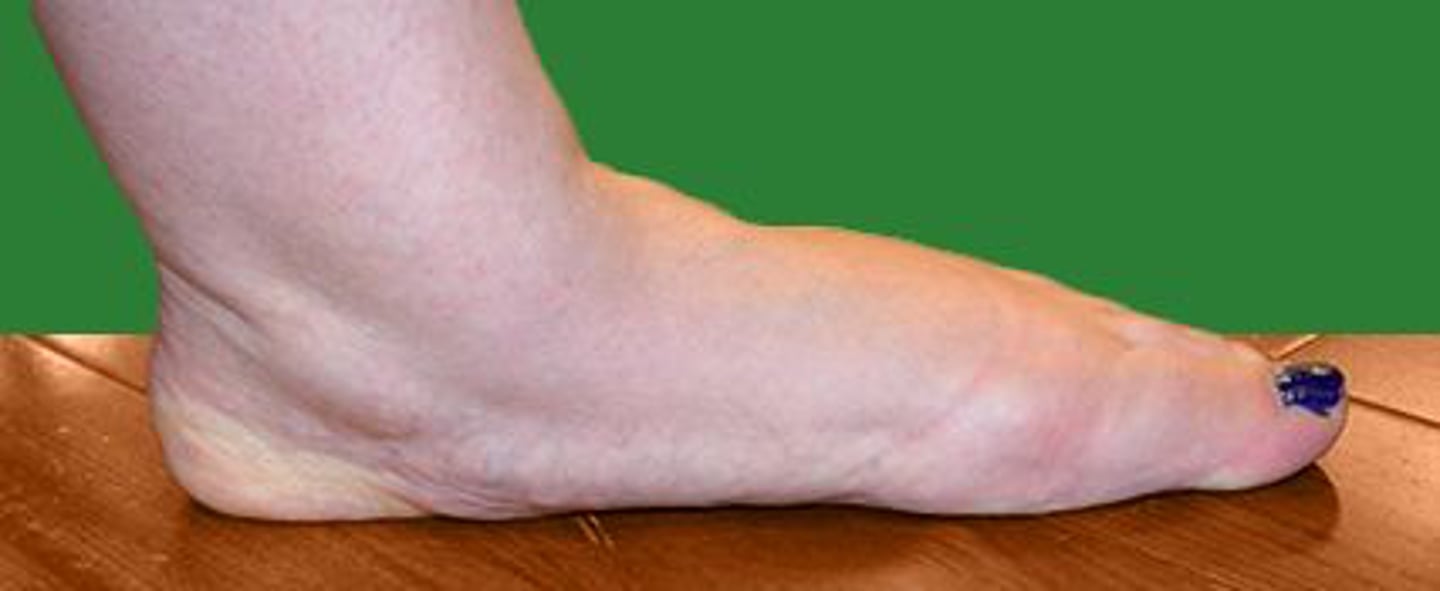
4
Which of the following recreational activities is MOST appropriate for a patient who has spinal stenosis?
1. Walking on a flat surface
2. Walking downhill
3. Swimming
4. Cycling
2
The exercise shown in the photograph targets which of the following structures?
1. External sphincter muscles
2. Obturator internus muscles
3. Hip adductor muscles
4. Urogenital diaphragm
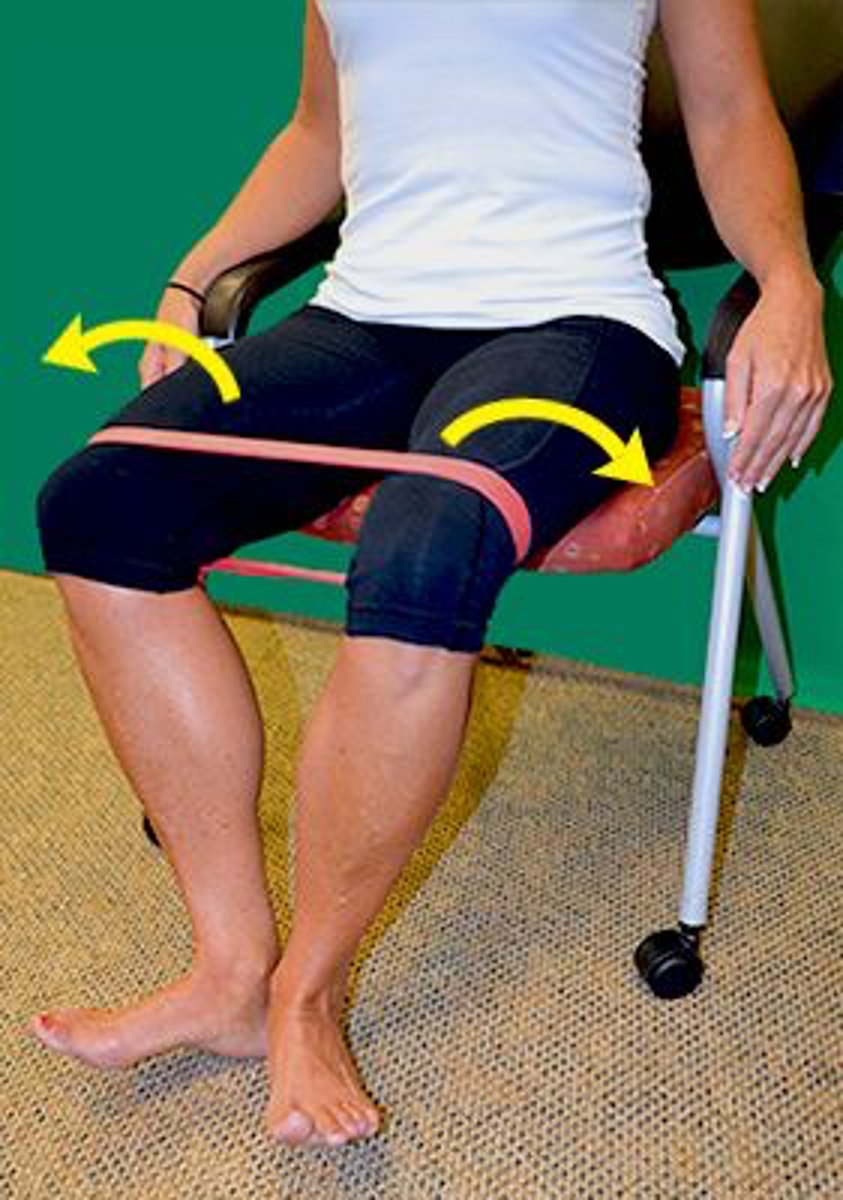
3
A patient who had a right cerebrovascular accident lacks hip extension at midstance on the involved side when walking. Which of the following interventions would be MOST effective to facilitate hip extension on the involved side?
1. Standing left hip abduction
2. Standing heel raises with the right leg
3. Standing with the right foot on top of a step
4. Side-stepping by crossing the left foot in front of the right leg
2
The patient in the photograph is positioned appropriately for a postural drainage treatment to which of the following areas of the lungs?
1. Upper lobes, anterior segments
2. Upper lobes, posterior segments
3. Lower lobes, superior segments
4. Lower lobes, posterior basal segments
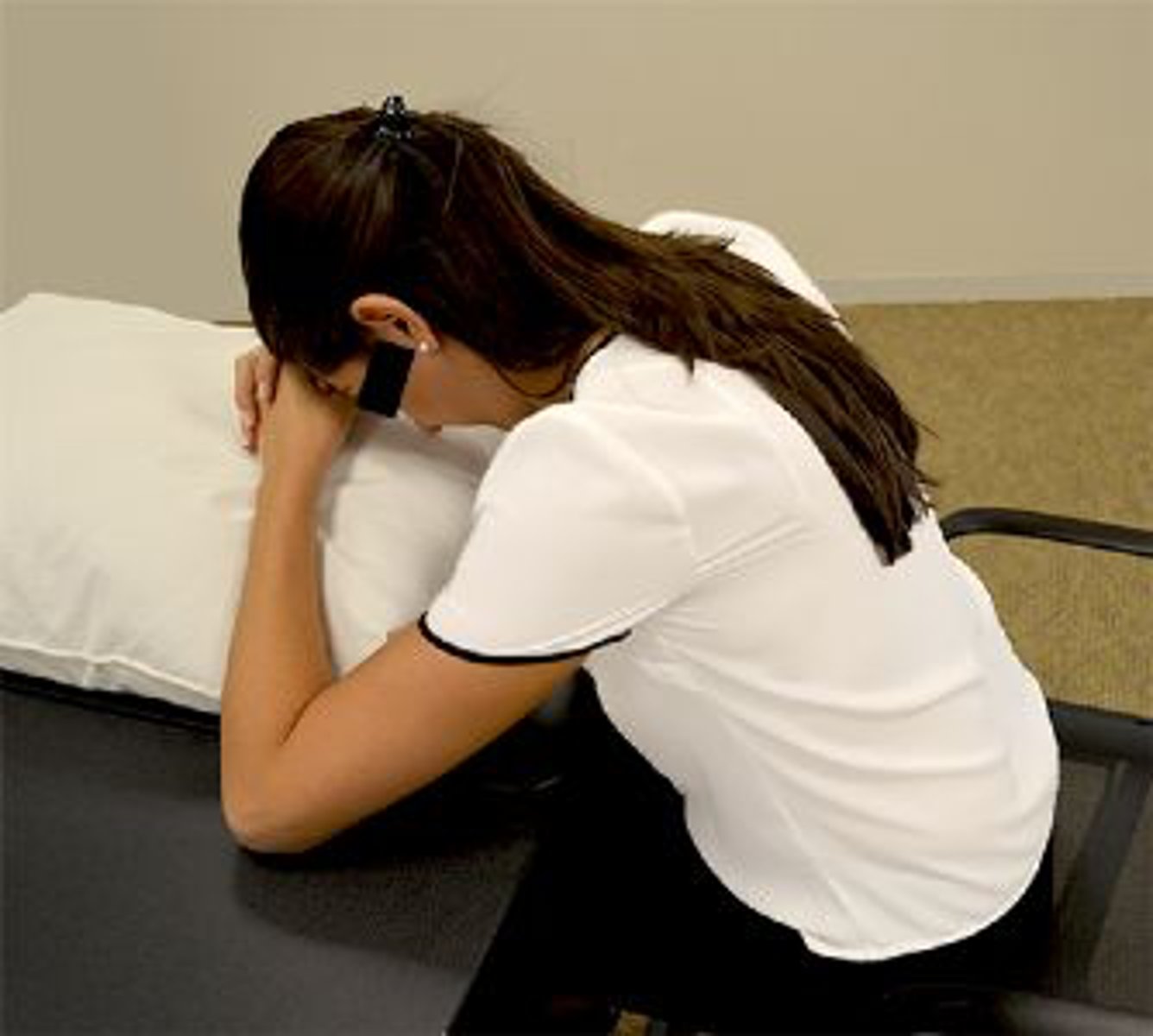
2
A patient had a total knee arthroplasty 4 days ago. Which of the following findings should be reported immediately to the physical therapist?
1. Pain rating of 8/10 during exercise, unchanged from the prior day
2. Increased erythema and red streaks originating from the surgical incision
3. Decreased erythema from the prior day in the area of the surgical incision
4. Quadriceps strength of Fair minus (3-/5) with increased pain during manual muscle testing
2
A patient has a history of breast cancer with radical mastectomy. Which of the following activities should be AVOIDED in the upper extremity on the surgical side?
1. Pulse oximetry
2. Measurement of blood pressure
3. Active range of motion exercises
4. Passive range of motion exercises
2
A physical therapist assistant notes that a patient is able to maintain an upright posture with eyes open but not with eyes closed. The patient is exhibiting which of the following signs?
1. Homans sign
2. Romberg sign
3. Tinel sign
4. Gower sign
4
Which of the following shoulder motions will be MOST limited in a patient who has adhesive capsulitis?
1. Flexion
2. Adduction
3. Medial (internal) rotation
4. Lateral (external) rotation
4
On the last day of treatment, a patient gives a $25 gift certificate to the physical therapist assistant. What is the MOST appropriate response of the assistant to this gesture?
1. Accept the gift, because the patient may be insulted if it is not accepted.
2. Refuse the gift, because accepting it may violate clinic policies.
3. Accept the gift, because it is not an excessive amount.
4. Refuse the gift, because accepting it may be unethical.
3
In which of the following scenarios would a patient's neuropathic ulcer be classified as grade 1 on the Wagner Ulcer Grade Classification?
1. Gangrene of the digit is present.
2. An abscess or osteomyelitis is present.
3. The ulcer is without subcutaneous tissue involvement.
4. Bone is exposed in the wound.
3
A patient has a full-thickness burn on the posterior aspect of the foot and leg. When a dressing is being applied to the burn, the ankle should be placed in which of the following positions?
1. Slight plantar flexion and slight eversion
2. Plantar flexion and slight inversion
3. Slight dorsiflexion and slight eversion
4. Dorsiflexion and slight inversion
2
A patient who has myasthenia gravis reports being unable to perform required exercises after doing housework and running errands, due to fatigue and weakness. Which of the following instructions for exercise is MOSTappropriate for the patient?
1. Gradually increase the amount of exercise in order to increase strength.
2. Alternate housework/errand days with exercise days.
3. Add light-weight resistive exercises to the program.
4. Continue the exercise program because it will decrease fatigue and increase strength eventually.
3
Which of the following instructions for self-care of the lower legs is MOST appropriate for a patient who has chronic venous insufficiency?
1. Dangle the legs off the side of the bed for several hours daily.
2. Walk as little as possible.
3. Elevate the legs above the level of the heart whenever possible.
4. Soak the legs in warm water 3 times/day.
3
For a patient who has peripheral artery disease, which of the following vital signs should be closely monitored for an abnormal response to exercise?
1. Heart rate
2. Temperature
3. Blood pressure
4. Respiration rate
2
Which of the following interventions would be CONTRAINDICATED for a patient who has spondylolisthesis?
1. Partial sit-ups
2. Prone press-ups
3. Electrical stimulation
4. Stretching the hip flexors
4
Cushing syndrome may be induced by which of the following medications?
1. Furosemide (Lasix)
2. Methotrexate (Trexall)
3. Insulin glargine (Lantus)
4. Hydrocortisone (Cortef)
3
A physical therapist assistant is using a tilt table with a patient who has been restricted to bed rest for several weeks. As the table is raised, treatment should be modified in all of the following instances EXCEPT when:
1. the patient reports dizziness and mild nausea.
2. the patient's systolic blood pressure drops 50 mm Hg.
3. the patient reports increased pressure from the footplate and straps.
4. the patient develops pallor and diaphoresis.
4
Redness on the inferior aspect of the patella upon removal of a transtibial socket prosthesis indicates that the residual limb:
1. is not far enough into the prosthesis, and fewer socks should be worn.
2. is not far enough into the prosthesis, and additional socks should be worn.
3. has slipped too far into the prosthesis, and fewer socks should be worn.
4. has slipped too far into the prosthesis, and additional socks should be worn.
4
To avoid the appearance of increased motion, which movement must be prevented during goniometric measurement of shoulder abduction?
1. Upward rotation of the scapula
2. Medial (internal) rotation of the shoulder
3. Lateral (external) rotation of the shoulder
4. Lateral flexion of the trunk to the opposite side